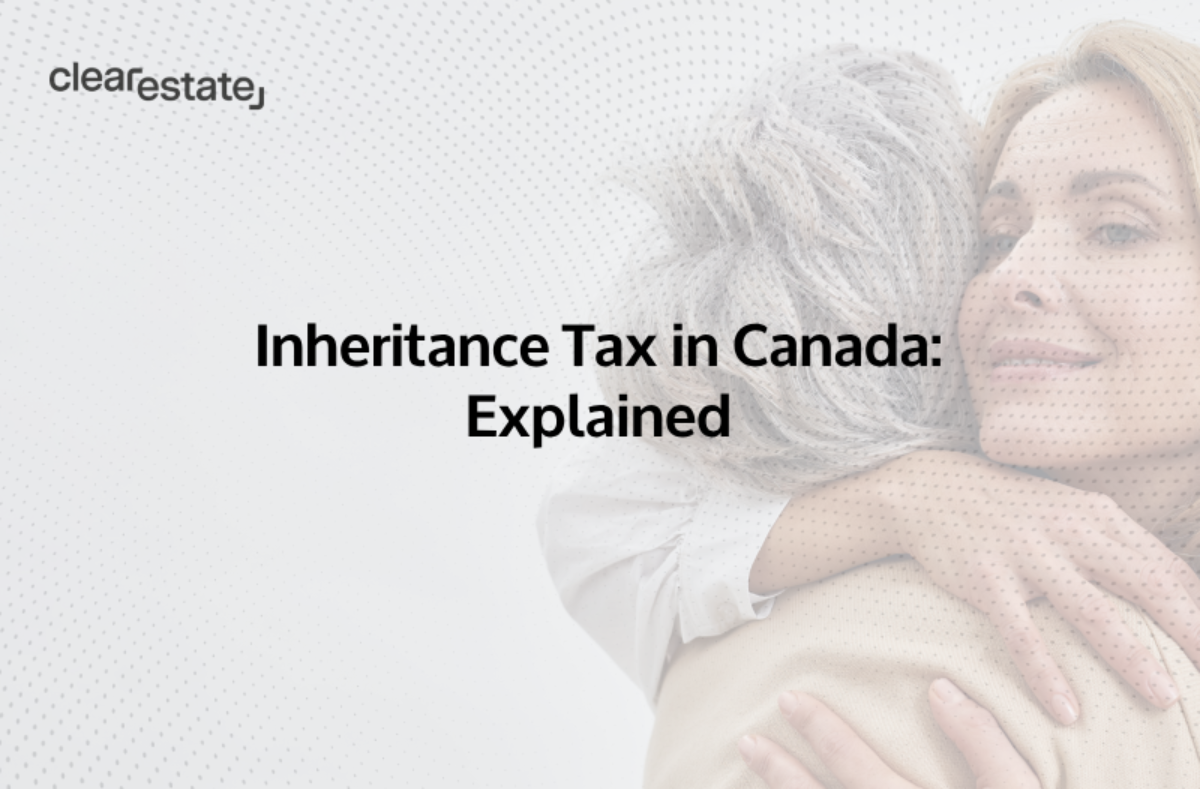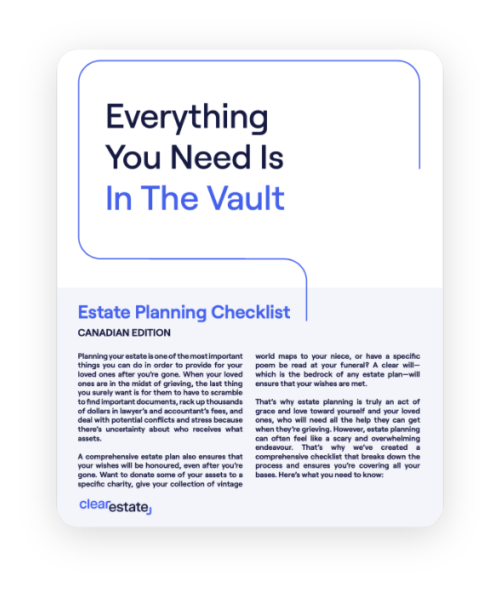Estate Planning
Oct 27, 2025
Introducing Empathy to Estate Bureaucracy
ClearEstate’s origin story: how grief, inefficiency, and compassion inspired Alex to build a fintech that brings empathy and efficiency to estate planning and settlement
Learn how estate taxes work in Canada. Understand deemed disposition, RRSP/RRIF taxes, and 3 proven strategies to minimize estate taxes.


Canada has no direct inheritance tax, but the Canada Revenue Agency (CRA) taxes estates through 3 main mechanisms:
1. Deemed disposition tax: Assets are treated as "sold" at death, triggering capital gains tax
2. RRSP/RRIF tax: Full value of registered accounts becomes taxable income
3. Provincial estate administration tax: Varies by province (e.g., 1.5% in Ontario above $50,000)
While in most cases beneficiaries don't pay tax on inherited assets, the estate pays tax before distribution.
Keep in mind that If you’re just beginning to navigate a loved one’s estate, be sure to follow what to do when someone dies in Canada before focusing on tax matters.
Instead of taxing the beneficiaries, Canada's Revenue Agency focuses on taxing the estate of the deceased before assets are distributed to beneficiaries. This approach ensures that any tax liabilities are settled before wealth is transferred to the next generation.
It's important to distinguish between inheritance tax and other taxes that may apply upon death. While beneficiaries don't face a specific inheritance tax, the estate may be subject to various forms of taxation that can impact the overall value of the inheritance.
Upon death, Canadian tax law treats the deceased's assets as if they were sold at fair market value. This concept, known as deemed disposition, can trigger capital gains tax on any increase in asset value since the original acquisition.
Capital gains tax on inheritance applies to the growth in value of assets like stocks, real estate (other than a principal residence), and other investments. The taxable portion is 50% of the capital gain, which must be reported on the deceased's final tax return.
For example, if an investment property was purchased for $200,000 and is worth $300,000 at the time of death, there's a capital gain of $100,000. Half of this gain ($50,000) would be added to the deceased's taxable income for their final tax return.
Registered Retirement Savings Plans (RRSPs) and Registered Retirement Income Funds (RRIFs) are treated differently upon death. Generally, the full value of these accounts is considered income in the year of death and is fully taxable.
This can result in a significant tax burden on the estate, as the entire value of the RRSP or RRIF is added to the deceased's income for the final tax return. However, there are exceptions to this rule, particularly when these accounts are transferred to a surviving spouse or an eligible dependent child or grandchild.
When transferred to an eligible beneficiary, the tax can be deferred, allowing for a potentially more tax-efficient transfer of these assets. This underscores the importance of careful beneficiary designation in estate planning.
While it's recommended to consult a tax professional for capital gains calculations, understanding the basic principles can be helpful. The key components are:
The capital gain is calculated by subtracting the adjusted cost base from the fair market value. Here's an example:
In Canada, 50% of capital gains are taxable, meaning $100,000 would be included in the deceased's final tax return.
An important benefit for beneficiaries: When you inherit a property, its cost base is "stepped up" to the fair market value as of the date of death. This means if you later sell the property, you'll only pay capital gains tax on any increase in value from the date of inheritance, not from the deceased's original purchase price.
The principal residence exemption is a powerful tool in Canadian tax law that can eliminate capital gains tax on a primary home. This exemption can significantly reduce the tax burden on an estate, especially in areas where property values have increased substantially.
To qualify for the exemption, the property must have been designated as the deceased's principal residence for each year they owned it. It's important to note that only one property can be designated as a principal residence per family unit per tax year.
Proper designation of a principal residence is crucial to maximize tax benefits. In cases where the deceased owned multiple properties, careful consideration should be given to which property should be designated as the principal residence to minimize overall tax liability.
The key to minimizing inheritance taxes lies in smart planning before you need it. While nobody enjoys thinking about estate planning, understanding a few key strategies can make a significant difference in preserving wealth for your loved ones.
Effective Estate Planning Techniques
Trusts are one of your most powerful tools for managing generational wealth transfer. Think of a trust as a financial container that holds and protects your assets while providing precise control over their distribution. While the concept might seem complex, their benefits are straightforward:
The Power of Lifetime Gifting
Beyond trusts, consider the strategy of lifetime gifting. Here's what makes this approach particularly attractive in Canada: unlike many other countries, we don't have a gift tax. This means you can transfer assets to your future beneficiaries while you're alive without triggering immediate tax consequences for them. Keep in mind though that as the giver, you'll need to consider potential capital gains implications.
Spousal Rollovers and Smart Beneficiary Planning
One of the most straightforward tax-saving tools is the spousal rollover provision. This allows for tax-free transfer of certain assets to your spouse or common-law partner, including:
Think of it as pressing a pause button on potential tax implications, giving your family more flexibility in managing the estate.
Optimizing Beneficiary Designations
The way you designate beneficiaries on your registered accounts can dramatically impact your estate's tax efficiency. This is particularly important for accounts like RRSPs, RRIFs, and TFSAs. By naming your spouse or qualified dependents as beneficiaries, you can often defer or reduce the immediate tax impact on these accounts.
Pro tip: Life changes constantly, so make reviewing your beneficiary designations a regular habit. Major life events like marriage, divorce, or having children should trigger a review of your beneficiary structure to ensure it still aligns with your goals while maintaining tax efficiency.
The executor of an estate has significant responsibilities when it comes to tax reporting. They must file the deceased's final tax return, which includes reporting all income up to the date of death, as well as any capital gains resulting from the deemed disposition of assets.
This process can be complex, especially for larger estates with diverse assets. The executor must gather all relevant financial information, calculate capital gains, and ensure that all tax obligations are met before distributing assets to beneficiaries.
Accurate reporting of capital gains tax on inheritance and other tax obligations is crucial. Errors or omissions can lead to penalties and interest charges from the Canada Revenue Agency (CRA), potentially reducing the value of the estate available for distribution.
A clearance certificate from the CRA is an essential document in the estate settlement process. This certificate verifies that all required taxes have been paid or that the CRA has accepted security for the payment.
Obtaining a clearance certificate is a critical step before distributing assets to beneficiaries. If an executor distributes assets without first obtaining this certificate, they can be held personally liable for any unpaid taxes owed by the estate.
The process of obtaining a clearance certificate involves submitting detailed information about the estate's assets and liabilities to the CRA. This can be time-consuming, but it's a necessary safeguard to ensure that all tax obligations have been met before the estate is closed.
Inheriting assets from other countries can introduce additional layers of complexity to the tax situation. Different countries have varying rules regarding inheritance and estate taxes, which can impact Canadian beneficiaries.
It's important to be aware of any foreign inheritance tax rules that may apply, as well as any reporting requirements for foreign assets. In some cases, you may need to report foreign inheritances to the CRA, even if no Canadian tax is due on them.
For estates with significant international components, seeking specialized advice for inheritance tax planning is crucial. Cross-border tax experts can help navigate the complexities of multiple tax jurisdictions and ensure compliance with all relevant laws and regulations.
While not technically a tax, probate fees (also known as estate administration taxes in some provinces) are an important consideration in estate planning. These fees vary by province and are typically calculated based on the value of the estate.
Probate fees can be substantial, especially for larger estates. In Ontario, for example, the estate administration tax is roughly 1.5% of the estate's value above $50,000. This can amount to a significant sum for high-value estates.
Minimizing probate fees is an important aspect of overall estate planning. Strategies such as joint ownership of assets, the use of beneficiary designations, and the establishment of trusts can help reduce the value of the estate subject to probate, potentially lowering these fees.
Inheritance and estate taxes in Canada requires careful planning and expert guidance. By understanding the nuances of deemed disposition, capital gains tax, and strategies for tax minimization, you can ensure that your legacy is preserved and efficiently transferred to your beneficiaries.
Remember, while Canada doesn't have a direct inheritance tax, proper estate planning is crucial to manage potential tax implications and maximize the value of your estate. Book a free consultation with our estate experts today to explore how we can help you create a comprehensive estate plan tailored to your unique needs and goals.
 Secure Your Legacy
Secure Your Legacy
Get your free 12-step Estate Planning checklist now. 89% of readers complete their estate plan within 3 months of using our guide.
Instantly Access Now